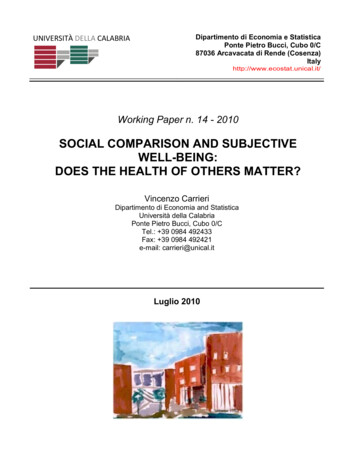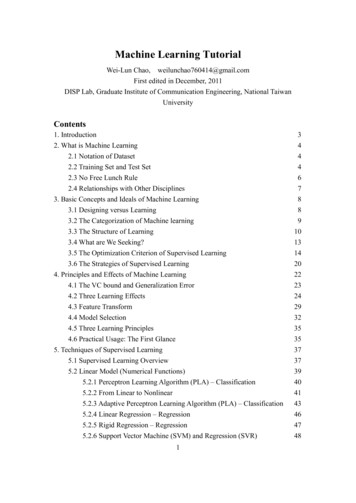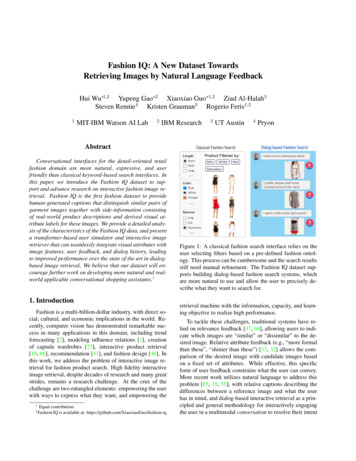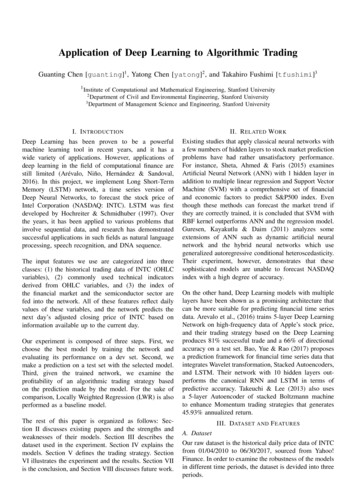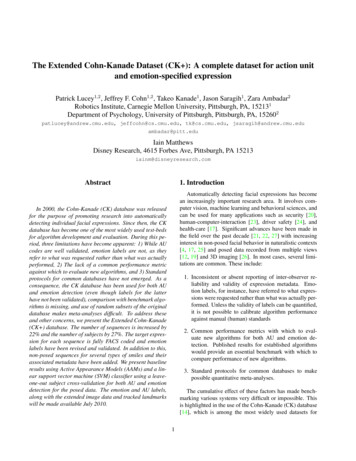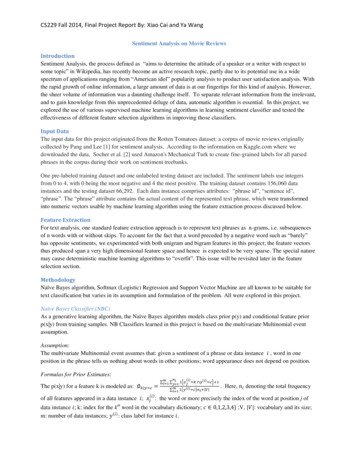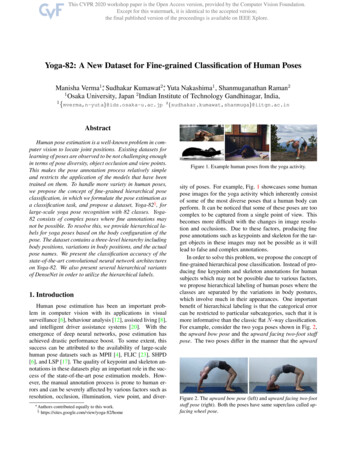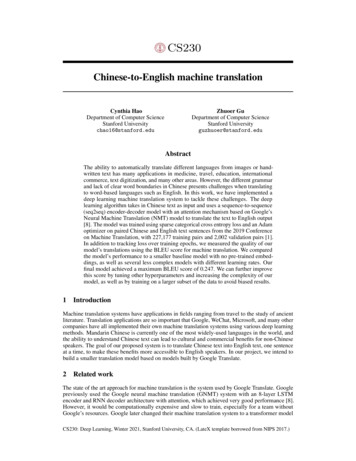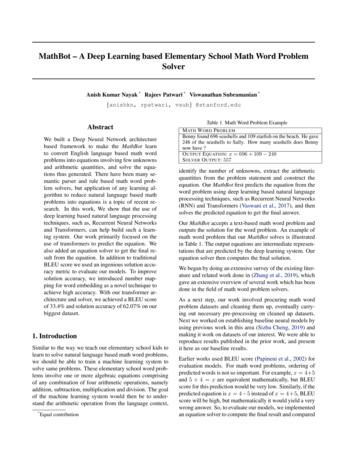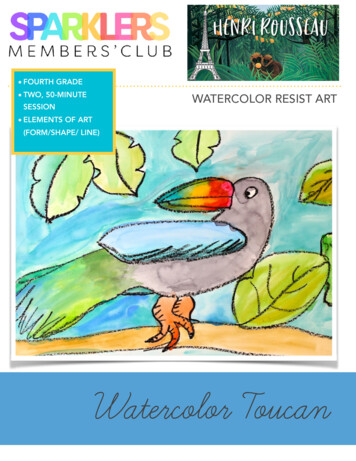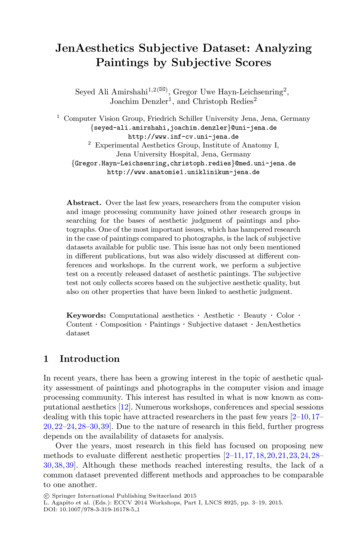
Transcription
JenAesthetics Subjective Dataset: AnalyzingPaintings by Subjective ScoresSeyed Ali Amirshahi1,2(B) , Gregor Uwe Hayn-Leichsenring2 ,Joachim Denzler1 , and Christoph Redies21Computer Vision Group, Friedrich Schiller University Jena, Jena, ena.dehttp://www.inf-cv.uni-jena.de2Experimental Aesthetics Group, Institute of Anatomy I,Jena University Hospital, Jena, ena.deAbstract. Over the last few years, researchers from the computer visionand image processing community have joined other research groups insearching for the bases of aesthetic judgment of paintings and photographs. One of the most important issues, which has hampered researchin the case of paintings compared to photographs, is the lack of subjectivedatasets available for public use. This issue has not only been mentionedin different publications, but was also widely discussed at different conferences and workshops. In the current work, we perform a subjectivetest on a recently released dataset of aesthetic paintings. The subjectivetest not only collects scores based on the subjective aesthetic quality, butalso on other properties that have been linked to aesthetic judgment.Keywords: Computational aesthetics · Aesthetic · Beauty · Color ·Content · Composition · Paintings · Subjective dataset · JenAestheticsdataset1IntroductionIn recent years, there has been a growing interest in the topic of aesthetic quality assessment of paintings and photographs in the computer vision and imageprocessing community. This interest has resulted in what is now known as computational aesthetics [12]. Numerous workshops, conferences and special sessionsdealing with this topic have attracted researchers in the past few years [2–10,17–20,22–24,28–30,39]. Due to the nature of research in this field, further progressdepends on the availability of datasets for analysis.Over the years, most research in this field has focused on proposing newmethods to evaluate different aesthetic properties [2–11,17,18,20,21,23,24,28–30,38,39]. Although these methods reached interesting results, the lack of acommon dataset prevented different methods and approaches to be comparableto one another.c Springer International Publishing Switzerland 2015 L. Agapito et al. (Eds.): ECCV 2014 Workshops, Part I, LNCS 8925, pp. 3–19, 2015.DOI: 10.1007/978-3-319-16178-5 1
4S.A. Amirshahi et al.Like in other fields of research that deal with quality assessment of stimuli,such as image and video quality assessment, subjective datasets [32–34,36,37]play an important role for research. Subjective datasets provide researchers withscores given by observers with regard to different properties of a stimuli. Thanksto the many photo-sharing websites nowadays used by professional and amateurphotographers, several subjective datasets [8,17,19,20,22,23] covering differenttypes and styles of photographs have been introduced to the public. These websites provide the user with a large number of photographs that have been ratedsubjectively by the community of photographers. The procedure for collectingsuch datasets is inexpensive both in the sense of time consumption and financialcost. It should be mentioned that a drawback of these datasets is that the scoringof images is not done in a standardized format. This means that the subjectivescores were likely given under various viewing condition using different displaying devices. To try to prevent such issues, in the field of image and video quality,subjective tests are normally collected using specific standards such as thosedescribed in [13]. Unfortunately, in the aesthetic quality assessment community,there is no specific standard agreed among different research groups with regardto how subjective tests should be performed as of yet.Unlike for photographs, there has been no public dataset of paintings withsubjective scores until recently. Last year, two small subjective datasets havebeen introduced to the community [2,39]. However, these datasets fall short ofcorresponding to the needs of the community, which we will describe in the nextsection.In this paper, we take advantage of the JenAesthetics dataset [1,5,15], whichis available for public use, and perform a subjective test to evaluate differentproperties of the paintings in this dataset. The JenAesthetics dataset is one ofthe largest publicly available datasets and covers a wide range of different styles,art periods, and subject matters [1,5]. The images in this dataset are colored oilpaintings that are all on show in museums and were scanned at a high resolution.The present study will combine the objective data previously provided in [5] withdifferent subjective scores.The next sections of this article are as follow: Section 2 introduces the previous subjective datasets. Section 3 describes the JenAesthetics subjective dataset.Section 4 evaluates the subjective scores provided by the observers. Finally,Section 5 gives a short conclusion and proposes possible future work to extendthis dataset.2Previous WorkBefore the introduction of the two mentioned datasets [2,39] (Sections 2.1 and2.2, respectively), other researchers [4,7,10,18,21,24,28] have gathered their owndatasets. This was done either by scanning high-quality art books, by orderingdigital samples from museums, or by using their own personal collections. Unfortunately, there is no possibility to release these datasets to other research groupsdue to copyright restrictions, making different approaches incomparable to oneanother.
JenAesthetics Subjective Dataset: Analyzing Paintings by Subjective Scores5Table 1. Comparison of different properties between the JenAesthetics subjectivedataset and the JenAestheticsβ [2] and the MART [39] subjective datasets. NA, notassessed.PropertiesJenAestheticsJenAestheticsβ [2]MART[39]Number of images1628281500Number of observers per painting19 - 214920Total number of observers13449100Scores of individual observersyesnoyesColor imagesyesyesmajorityAverage image size (pixels)4583 44342489 2517513 523Number of properties evaluated51 (beauty)1 (emotion)Rating scalecontinuous, 1-100ordinal, 1-4ordinal, 1-7Art periods/styles11NA1Number of subject matters16NA1Number of artists4103678In the following subsections, we will give a short summary on the two available subjective datasets [2,39]. Table 1 lists different properties of the availablesubjective datasets.2.1JenAestheticsβ [2]This dataset, which was introduced in 2013, consists of 281 paintings of differentsubject matters and art styles. A positive aspect of this dataset is the highnumber of observers who rated the images. The subjective scoring in this datasethas been done based on a scale of 1-4. Subjective scores show that paintings withbluish or greenish colors are generally given higher subjective scores comparedto paintings with brownish or dark colors [2]. This result confirms findings byPalmer and Schloss [25]. Compared to the JenAesthetics dataset [1,5,15], thisdataset does not provide information on the art periods which the paintingsbelong to, and no subject matters are assigned to the paintings.2.2MART Dataset [39]This subjective dataset of paintings consists of 500 abstract paintings producedbetween 1913 and 2008. The paintings were selected from the MART museum inRovereto, Italy. The images in this dataset were divided into 5 subsets, each consisting of 100 images. 20 observers rated each subset based on a 7-point ratingscale. The observers were mostly female (74 females, 26 males) and on average visited 5.5 museums per year. The observers were allowed to spend as much
6S.A. Amirshahi et al.time as they wanted to see and observe a painting before giving a score, but theywere advised to rate the paintings in the fastest possible manner. 11 images arein a monochrome format (Table 1). Also, the average pixel size of the imagesis relatively small compared to the JenAesthetics and the JenAestheticsβ [2]datasets. Unlike these two datasets, the paintings of the MART dataset belongto a single art period/style (i.e., abstract art).3JenAesthetics Subjective DatasetIn collecting the JenAesthetics dataset [1,5,15], Amirshahi et al. took advantageof the fact that the Google Art Project (http://www.googleartproject.com/) hasreleased a large number of high-quality scanned versions of artworks for publicuse. Although the artworks in this dataset are mostly from famous painters, thisdoes not guarantee that they will be ranked highly by non-expert observers. Thenon-expert observers who participated in our experiment were not familiar withmost of the paintings and/or painters. The importance of familiarity in evaluating the quality of a photograph or painting has been noticed in different studies[8,18]. A painting is labelled as familiar in the JenAesthetics subjective dataset ifthe observer believes that he/she has previously seen the painting or if they knowthe painter. Moreover, as it will be discussed in Section 4, some famous paintingsare not among paintings with the highest subjective scores. This implies thatthe observers are not necessarily biased towards famous paintings.As mentioned previously, there is a lack of standards for subjective tests inthe field of computational aesthetics. We believe that the following issues haveto be taken into account when performing a subjective test of paintings.1. Tests should be carried out under standard viewing conditions in a controlledenvironment. This will ensure that the observers are viewing all paintingsunder the same condition so that the scores are comparable.2. The observers should not be familiar with the paintings. Different approacheshave been taken to prevent the subjective scores from being biased towardsa familiar painting. For example, Li et al. [18] removed scores given byobservers when they expressed that they were familiar with the paintingshown. In our work, we found that the observers were not familiar with thevast majority of paintings evaluated.3. Multiple properties should be assessed and not just one. For example, if weevaluate the aesthetic quality as well as the observers’ liking of the colors,composition, and content of the paintings, as done for the JenAestheticssubjective dataset in the present study, we can correlate each preferencewith the aesthetic scores given by the observer (see Section 4.2).4. The visual ability of the observer should be taken into account. Resultsprovided from observers with visual impairment should be treated differentlycompared to other observers.In the following sections, we will first provide information on why specificquestions/properties were evaluated by the observers (see Section 3.1). We willthen describe the experimental procedure (see Section 3.2).
JenAesthetics Subjective Dataset: Analyzing Paintings by Subjective Scores7Table 2. Questions that the observers were asked for each property in the JenAesthetics subjective dataset. The two terms visible on the rating scale which correspondto the highest and lowest possible scores are also shown.PropertyQuestion askedLeft sideRight sideAesthetic qualityHow aesthetic is the image?not aestheticaestheticBeautyHow beautiful is the image?not beautifulbeautifulLiking of colorDo you like the color of theimage?noyesLiking of contentDo you like the content ofthe image?noyesnoyesLiking of composition Do you like the compositionof the image?Knowing the artistDo you know the artist?noyesFamiliarity with thepaintingAre you familiar with thispainting?noyes3.1Properties EvaluatedTable 2 gives an overview on the properties evaluated in the JenAesthetics subjective dataset. The main goal for the dataset is to collect subjective scoresrelated to the aesthetic quality of paintings. Previous works have taken differentapproaches to reach this goal. While in the case of the JenAestheticsβ datasetAmirshahi et al. [2] used beauty as their measure, Li et al. [19] asked their subjects to give their general opinion about the painting. For the MART dataset [39],the observers were asked to give a score with regard to their emotion towardsthe paintings. In this experiment, the lowest score represented the most negativeemotion while the highest score represented the most positive emotion. In theJenAesthetics subjective dataset, we evaluate subjective scores with regard toboth aesthetic quality and beauty. The two properties are compared in Section4.2.We also evaluated three other properties (i.e., the liking of color, composition and content of the paintings) and studied the relationship between theseproperties and the aesthetic and beauty scores (see Section 4.2). Previously,Amirshahi et al. [2] and Yanulevskaya et al. [39] used simple color features topredict the aesthetic quality of paintings with a high accuracy. Other workssuch as [25,26,31] have also focused on the importance of color when evaluatingthe aesthetic quality of images. The composition of an image (for example therule of thirds) plays an important role in the aesthetic quality of paintings andphotographs according to several studies [3,8,16,18,20,35,38]. Finally, it is wellknown that the content of a painting and/or photograph can influence the subjective rating of aesthetic quality. In the JenAesthetics dataset, the content ofpaintings is represented by the subject matter.
8S.A. Amirshahi et al.Table 3. Characteristics of the JenAesthetics subjective dataset.AttributeValueNumber of participants134Number of observers after removing clickersand people with color blindness129Number of observation sessions190Age range of the observers19 to 42 yearsMean age25.3 yearsMale / female70 / 59Right / left-handed119 / 10With / without glasses64 / 65Interested / not interested in art90 / 39Nationality15 different countriesNationality represented most frequently103 from GermanyTo evaluate whether the subjective scores are in any way biased by beingfamiliar with a painting, the observers’ familiarity towards each painting wasassessed. We also asked the observers whether he/she knew the painter. A similarapproach was taken by Li et al. [18].3.2Experimental ProcedureParticipants 134 participants attended this study; sixty-seven of them tookpart in two observation sessions (leading to a total of 201 sessions). Most ofthem were students, in particular of natural sciences, but other fields of studiesand professions were reported also. However, no participant was a student ofarts, art history, or any related field. All participants declared having normalor corrected-to-normal visual acuity and gave their written informed consentafter receiving an explanation of the procedures. The consent allows us to useand share their subjective scores. Each participant was tested for color blindnessusing the Ishihara test [14]. Data from observers who were color blind wereexcluded from the analysis. See Table 3 for additional data on the participants.Stimuli We used the 1628 art images from the JenAesthetics database [1] asstimuli. In every session, a subset of 163 images were rated. Works from 410painters are available in this dataset. The dataset covers paintings from 11 artperiods (Renaissance, Baroque, Classicism, Romanticism, Realism, Impressionism, etc.). Each painting in the dataset is tagged with up to three different subject matters. These subject matters (16 in total) include abstract, landscape,still life, portrait, nude, urban scene, and etc.
JenAesthetics Subjective Dataset: Analyzing Paintings by Subjective Scores9Procedure The experiment was performed using the PsychoPy [27] program(version 1.77.01) on a BenQ T221W widescreen monitor with a resolution of1680 1050 pixels (WSXGA ). The monitors where calibrated with a colorimeter (X-Rite EODIS3 i1Display Pro) using the same calibration profile in orderto create similar conditions for all observers.For presentation, each image was scaled so that the longer side of the imagewas 800 pixels on the screen. The images were placed in the middle of the screenon a black background (see Figure 1). Images were presented with a size of 20.5cm (longest side) on the computer screen, corresponding to about 19.4 degreesof visual angle (at a viewing distance about 60 cm).First, twenty images from the dataset that were not used in the rating experiment were presented for three seconds each to get the observer used to the data.Then, 163 images that were selected randomly from the dataset were presented to the observer in a random order. Careful attention was taken so thatno two subsets where identical. In total, each painting was rated by 19 to 21observers. The participants were asked to rate the images on seven propertiesusing a sliding bar located on the bottom of the screen. Internally, the slidingbar was binned into 100 equal intervals. Accordingly, the ratings obtained (seeFigures 3-8) ranged from 0 to 100. The rated properties were “Aesthetic quality”, “Beauty”, “Liking of color”, “Liking of content”, “Liking of composition”,“Knowing the artist”, and “Familiarity with the painting” (see Table 2 for detailson the presented questions). As shown in Figure 1, the questions were presentedabove the sliding bar. The terms presented in Table 2 indicated the range forthe rating at each end of the bar. The observers where instructed that the mentioned phrases on the scoring bar were to represent the two extreme cases forthe scores and that their scores would not be treated on a binary scale. The participants had no time restrictions for answering each question. After rating, thenext question appeared. The image was visible until the last rating was given.Participants who attended a second session were provided with a new randomlyselected set of images that shared no images with the images shown in the firstsession, in which they participated.4Analysis of the Subjective ScoresThe first step in analyzing the subjective scores gathered was to remove thescores that were provided by observers in an improper manner. These scoreswere mainly provided by what will be referred from here on as clickers. Clickers are observers who provide their results by randomly clicking the score bar,independent of the image content or the question asked. The random clickingof the score bar is mostly performed at a high speed resulting in short responsetimes (Figure 2(a)). Also, clickers tend not to move their mouse for a few questions before moving their mouse to another position (Figure 2(b)). Subjectivescores for each property were calculated after removing the scores provided bythe clickers. After removing the clickers and the scores provided by people whowere color blind, the total number of observers was 129.
10S.A. Amirshahi et al.Fig. 1. Screen-shot from the subjective test for one of the assessed properties (aesthetic quality). The question regarding the assessed property is represented under thepainting. Painting by Peter Paul Rubens, about 1617.(a)(b)Fig. 2. Comparing results from a clicker and a normal observer. (a) Response timespent on each image. (b) Scores given to the seven properties for 17 paintings selectedrandomly for the same observers whose response times are shown in (a).4.1Calculating the ScoresAfter removing the clickers from the obtained data, the final step in producing asubjective datatest was to calculate a score for each property for each painting.Among the different options available, we decided that calculating the medianvalue between the scores would be the best possible option. This is mainly totake into account the small chance that some scores are given in an incorrectway. For instance, the score might have been given by accidentally clicking the
JenAesthetics Subjective Dataset: Analyzing Paintings by Subjective Scores(a) 92(b) 91(c) 89(d) 85(e) 12(f) 21(g) 2111(h) 24Fig. 3. The four paintings ranked highest for their aesthetic quality are marked bya green border ((a)-(d)) and the four paintings ranked lowest by a red border ((e)(h)). The scores given to each painting is presented below each image. (a) AntonioCanaletto, 1738, (b) Antonio Canaletto, 1749, (c) Pieter Jansz Saenredam, 1648, (d)Dosso Dossi,1524, (e) Quentin Matsys, 1513, (f) Édouard Vuillard, 1900, (g) ErnstKirchner, 1910, (h) Ernst Kirchner, 1920.(a) 95(b) 92(c) 91(d) 91(e) 2(f) 10(g) 13(h) 13Fig. 4. The four paintings ranked highest for their beauty are marked by a green border((a)-(d)) and the four paintings ranked lowest with a red border ((e)-(h)). The scoresgiven to each painting is presented below each image. (a) Edmund C. Tarbell, 1892, (b)Antonio Canaletto, 1738, (c) Félix Ziem, 1850, (d) John Constable, 1816, (e) QuentinMatsys, 1513, (f) Ernst Kirchner, 1910, (g) Francisco Goya, 1812, (h) Édouard Vuillard,1900.score bar. Using the median scores provides us with a better chance to removethese outliers and achieve a more accurate score. Figures 3-7 represents the fourhighest rated paintings (marked by a green border) and the four lowest ratedpaintings (marked by a red border) for the first five properties introduced inTable 2. Figure 8 represents the distribution of the scores for each property. Asshown in the figure, the median value of the subjective scores for all propertiesis around the mid-point of the score range. Note that the subjective scores covera wide range of the score bar.As mentioned before (Table 2), the observers were asked two more questionswith regard to the familiarity of the paintings and the painter who created thepainting. Results revealed that a majority of the paintings neither looked familiarnor did the observers know the painter (in both cases, 99% had a score of lessthan 10%). This finding suggests that the results for the other five propertiescannot have been substantially influenced by familiarity of the observers withthe paintings.
12S.A. Amirshahi et al.(a) 98(b) 96(c) 95(d) 93(e) 14(f) 16(g) 17(h) 18Fig. 5. The four paintings ranked highest for their liking of color are marked by a greenborder ((a)-(d)) and the four paintings ranked lowest with a red border ((e)-(h)). Thescores given to each painting is presented below each image. (a) Edmund C. Tarbell,1892, (b) P. C. Skovgaard, 1857, (c) Childe Hassam, 1913, (d) Antonio Canaletto, 1738,(e) Edgar Degas, 1890, (f) Isidre Nonell, 1903, (g) Pierre Puvis de Chavannes, 1881,(h) Ernst Kirchner, 1920.(a) 95(b) 95(c) 94(d) 93(e) 11(f) 13(g) 13(h) 14Fig. 6. The four paintings ranked highest for their liking of composition are markedby a green border ((a)-(d)) and the four paintings ranked lowest with a red border((e)-(h)). The scores given to each painting is presented below each image. (a) AntonioCanaletto, 1738, (b) Johan Christian Dahl, 1839, (c) Viktor Vasnetsov, 1881, (d) JohnSingleton Copley, 1765, (e) Émile Bernard, 1892, (f) Paul Cézanne, 1877, (g) IsidreNonell, 1903, (h) Marcus Gheeraerts the Younger, 1591.(a) 97(b) 93(c) 93(d) 93(e) 3(f) 7(g) 10(h) 11Fig. 7. The four paintings ranked highest for their liking of content are marked by agreen border ((a)-(d)) and the four paintings ranked lowest with a red border ((e)-(h)).The scores given to each painting is presented below each image. (a) Johan ChristianDahl, 1839, (b) Childe Hassam, 1913, (c) Anton Mauve, 1887, (d) David Teniers theYounger, 1652, (e) Quentin Matsys, 1513, (f) Felice Boselli, 1690, (g) Jusepe de Ribera,1621, (h) Abraham Staphorst, 1665.4.2Relationships Between Subjective ScoresNext, we investigated the relationships between the subjective scores of the different properties by calculating the Spearman correlation coefficient.
JenAesthetics Subjective Dataset: Analyzing Paintings by Subjective Scores100100median 58Number of paintingsNumber of paintings806040200020406080median 528060402001000201001008080median 58604020204060608010080100(b) beautyNumber of paintingsNumber of paintings(a) aesthetic quality040Subjective scoresSubjective scores01380median 596040200100020Subjective scores4060Subjective scores(c) liking of color(d) liking of compositionNumber of paintings150100median 51500020406080100Subjective scores(e) liking of contentFig. 8. Histograms representing the score distribution of the median score for differentproperties evaluated in the JenAesthetics subjective dataset. Images defined as havinghigh quality are shown in green and images defined as having low quality in red (seeSection 4.2). The blue values represent intermediate values with the median valueindicated.
14S.A. Amirshahi et al.Table 4. ρ values calculated for Spearman correlation between subjective scores fordifferent properties. All values are significantly different from zero (p 0.01).PropertiesAesthetic qualityAesthetic BeautyqualityLiking Likingof Likingof color composition contentof1Beauty.78021Liking of color.6676.72371Liking of composition.7114.7642.65061Liking of content.6216.8110.5945.70101The following findings deserve further comments:– The highest correlation is seen between liking of content and beauty. Thefact that the content and subject matter of a painting plays a crucial role forhow an observer evaluates a painting was mentioned previously in [1]. Otherworks emphasize this fact for other stimuli, such as [16] for webpages.– The second highest correlation is between subjective aesthetic quality andbeauty scores. Keeping in mind that the Oxford dictionary defines aestheticas “concerned with beauty or the appreciation of beauty”, such a high correlation is not a surprise.– Previous studies have related different composition techniques such as therule of thirds, the golden ratio, etc. to the beauty and aesthetic qualityof paintings and photographs [3,8,18,20,26,35,38]. In the present study, thecorrelation between the liking of composition and beauty is the third highestcorrelation, and the correlation between aesthetic quality and the liking ofcomposition is the fifth highest correlation.– With regard to the liking of color, studies such as [2,25,26,31] have emphasized the importance of color on subjective aesthetic and beauty scores. Thisaspect was also seen in the correlation between the scores given to the likingof color and ratings for beauty and aesthetic quality.– The correlation between the beauty scores and the mentioned three properties (liking of color, content, and composition) are among the highest (fourth,third, and first, respectively). In contrast, the correlation for aesthetic quality with the three properties is not as high as that of beauty (seventh, fifth,and ninth, respectively).We also implemented a five-fold cross validation classifier using a linear SVM.This was done to enable users of the dataset to compare the present performanceof a classifier with their own classifiers based on the subjective scores providedin the present work.For the each property in our classification, we divide the images into twogroups (high quality and low quality). The assigning of the groups is done basedon the subjective score for each image. If the image has a subjective score greater
JenAesthetics Subjective Dataset: Analyzing Paintings by Subjective Scores15than M edian(allscores) 10, the image will be labelled as high quality and ifthe subjective score is lower than M edian(allscores) 10, it will be labelled aslow quality. The other remaining properties are used as features in our classifier.Average recognition rates of this classification procedure are listed in Table 5 fordifferent scenarios. From this table we can conclude that:– High classification rates were found between subjective aesthetic quality andbeauty scores and the other three properties. This finding was previouslyseen for the correlation rates (Table 4) and supports the notion that theseproperties (liking of color, composition and content) are closely related tothe aesthetic quality and beauty judgement (see Section 3.1).– Using the subjective scores provided for the liking of color and contenttogether in our feature vector resulted in high recognition rates for beauty.As mentioned above, a close relation of color liking and beauty perceptionhas been previously pointed out in the literature.– Similar to the correlation rates shown in Table 4, the lowest classificationrate is for the case in which either the liking of color or the liking of contentis used as a feature to classify the other property. This result is not surprisingsince the two mentioned properties are usually not related to one another inpaintings.5Discussion and Future WorkIn this paper, we present subjective ratings of the previously introduced JenAesthetics dataset. We hope that such a public dataset of paintings along withtheir subjective scores will provide a significant contribution to the computational aesthetic community. The lack of a publicly available subjective dataset ofpaintings has been mentioned numerous times in different publications and/ormeetings. The subjective dataset comprises scores for five different properties(aesthetic, beauty, and liking of color, composition, and content). The scoreswere gathered by performing 190 observation sessions by 129 observers. Theresults show that the properties assessed are highly correlated with one another.It was interesting to see that the subjective scores related to the liking of color,composition and content had a higher correlation with beauty scores than withaesthetic scores. This finding shows that a high aesthetic quality of a paintingdoes not necessarily mean that the color, content, or composition are pleasing to the observer as well. The fact that the subjective scores for beauty andaesthetic quality were highly correlated confirms findings from previous studies[1–3,8,16,18,20,25,26,31,35,38].Compared to previous datasets, the JenAesthetics subjective dataset containsa larger number of paintings and covers a wider range of different subject matters,styles and art periods. It also evaluates different properties providing the userwith many different scenarios to test and evaluate.In the future, we will increase the number of images assess
Paintings by Subjective Scores Seyed Ali Amirshahi1,2(B), . [1,5]. The images in this dataset are colored oil paintings that are all on show in museums and were scanned at a high resolution. . This was done either by scanning high-quality art books, by ordering digital samples from museums, or by using their own personal collections. .
